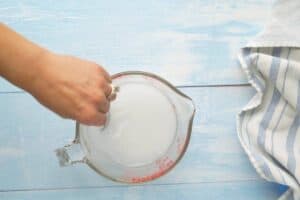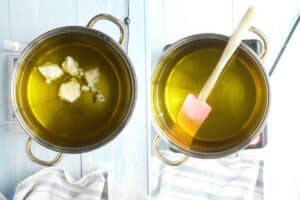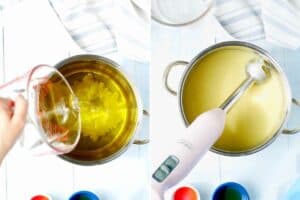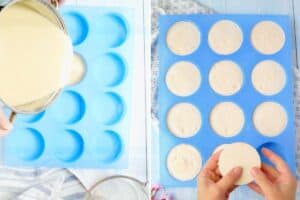Bastille Soap Recipe
A simple to make cold process soap that's gentle and nourishing for your skin.
Equipment
- soap mold (I prefer a cavity mold rather than a loaf mold for this recipe)
- Safety equipment (gloves, goggles, and an apron)
Ingredients
- 25 ounces olive oil
- 2 ounces shea butter
- 3.46 ounces lye
- 8.5 ounces water
Instructions
- Make the lye water. Measure out the lye and water in separate containers using a digital scale. Slowly add the lye to the water, stirring continuously until fully dissolved. Note that the mixture will heat up and become cloudy. Set aside to cool in a well-ventilated area.

- Melt the oils. Measure the oils separately, then combine them in a large pot. Melt the olive oil and shea butter over medium-low heat until the shea butter is fully melted. (You may find it helpful to soften the shea butter in the microwave first, as it's slow to melt.) Set aside to cool.

- Stick blend to trace. Once the lye water and oils have cooled to about 100-115 degrees, pour the lye water into the pot with the oils. Get your soap molds and any fragrance or color you add. Using a stick blender, mix until the mixture reaches 'trace' (the consistency when droplets sit on the surface briefly before sinking in). Then, add any desired fragrances or colors.

- Cure and unmold. Pour the soap mixture into the mold. Tap the mold gently on a firm surface to remove any air bubbles. Allow the soap to set in the mold for 24-48 hours before unmolding. Then, cure the unmolded soap in a cool, dry place for at least 3 weeks before use.

Notes
Make sure you have all the ingredients, equipment, and safety gear you'll need and that they are easily accessible. This will make the process smoother and safer, especially when working with lye.
For this recipe, I suggest using a silicone mold with eight cavities, each capable of holding five ounces. This will make it easier to remove the soap from the mold and ensure that each bar is the same size and shape.
The longer you let the soap cure after removing it from the mold, the longer it will last.
It's also important to maintain the right temperature for both the lye solution and the oils. Use a thermometer to check that they're between 100-115°F before mixing to help the soap blend smoothly and saponify properly.
Remember to follow all safety precautions when working with lye and soap batter, as they can be dangerous if not handled properly.